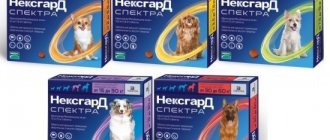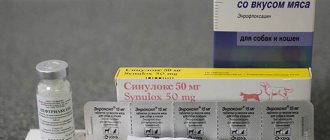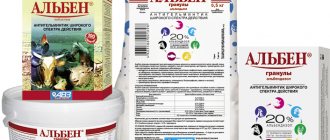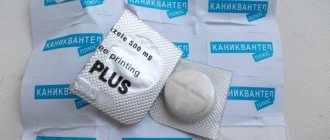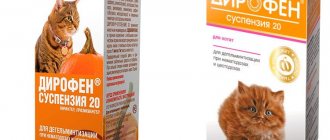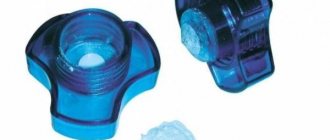6508Pavel
Cats can become infected with worms anywhere: at home, on the street, through food, drinking water, or from a person or other sick animal. Treatment must be started immediately; such problems in the body can lead to a deterioration in the pet’s condition and its death. Anti-worm medications for cats are sold at any veterinary pharmacy.
A doctor will help you choose the right treatment so as not to harm the animal. If owners are able to identify the disease themselves, then at the initial stage the drugs will save the pet.
The first signs of worms:
- excessive thinness
- vomiting, intestinal upset
- red spots under the fur
- there is pus near the eyes, a rash on the ears
- After defecation, the cat rubs its anus
© shutterstock
Helminths are divided into three types:
- Cestodoses
- Nematoses
- Trimatoses
The latter are the most dangerous of the worms. Self-treatment will not bring results. You can save your pet only through complex procedures in a special clinic, and the veterinarian will prescribe the drug and save the cat from suffering. In other cases, there are a number of deworming medications that can prevent the problem.
Various release forms:
- Suspension or paste
- Drops
- Pills
- Injections
Anti-worm medications for your pet should be chosen based on its character. Cats do not like to take medications, so you need to try giving them different types. All of them are effective, regardless of the form.
The suspension is attractive due to its convenient packaging . Available as a liquid, administered with a syringe with a dispenser. The following drugs are most popular against worms:
- Prazitel - used for a wide spectrum of action. It enters the body quickly and leaves it in about 48 hours. It is allowed to give to cats older than 3 weeks, pregnant females in the second stage.
- Prazicide - dosage forms are packaged for all ages of the animal. This anthelmintic drug is sold in one dosage for kittens and in another for adult pets.
- Helminthal - intended for those animals that are 6 weeks old. Prescribed for the treatment of mixed invasions, for prophylactic purposes. No side effects have been identified; individual intolerance to the components is possible.
© shutterstock
Drops, according to pet owners , are considered the best anti-worm medications for cats of any age. A convenient release form with a dispenser allows you to painlessly give the medicine to your pet. Most often, drops for the withers are prescribed as follows:
- Profender, a drug from a popular German company, is good for cats that are 8 weeks old and weigh more than 0.5 kg. Contains the active ingredients emodepsin and praziquantel. Sold packaged in pipettes, quantity 2 pieces per box with attached instructions for use. Do not apply to wet, damaged skin.
- Helmintal-K - drops on the withers of adult cats. The drug rids the animal of worms, insects living on its surface. Not recommended for pregnant or lactating pets, or kittens less than 7 weeks old. Prescribed against nematodes, cestodes, and other diseases caused by insects. Treat animals weighing more than 4 kg, 0.1 ml. liquid per kilogram.
- Inspector TOTAL K is a drug with a multi-spectrum action. Relieves cats of worms and external parasites: fleas, ticks, scabies. The treatment is carried out once, only further treatment is needed. It is forbidden to use by weakened animals whose weight is less than 1 kg, those with infectious diseases, lactating, pregnant females, kittens whose age is not more than 1.5 months.
- Inspector spray is a widely used product, suitable for cats and dogs, effective. Toxic, treatment is carried out in the open air, away from flammable objects. Children, ornamental birds, and aquarium fish should not be near them. When applied, the animal must be muzzled, with its neck closed and jaw fixed. Such measures are necessary to prevent drops from being licked off.
Drops on the withers against worms for cats are simple to use, however, you should keep an eye on your pets. Preparations in this release form are quickly washed off with water; this is not advisable before the specified time. Strict control of animals will help to avoid unforeseen situations.
tablets for deworming , it is not difficult to choose the appropriate option for your pet, the main thing is that he swallows it. The best anthelmintic drugs for cats in this form of release are as follows:
- Milbemax - the medicine is given once. Produced for both adult and small animals. It is not advisable to use the deworming drug for cats whose weight does not exceed half a kilogram; their age should be more than 6 weeks. Use with caution; adverse reactions are possible.
- Pratel - the effect of the drug begins 3-4 hours after use. The worms are completely eliminated after a few days. It is prescribed to cats at any age, the only difference is in the dosage. Babies from 6 weeks of age are prescribed 1/4 of the tablet, adults - half of the tablet.
- Milprazone, an anti-worming drug, is available in two types: for pets weighing less than 2 kg, and for those whose body weight is higher. It is prohibited for animals under 1.5 months of age, those suffering from infectious diseases, lactating and pregnant cats. Overdose is possible, it is recommended to use when prescribed by a veterinarian. Toxic to other mammals: birds, fish.
- Kanikquantel Plus is produced in the form of gels and tablets. The dosage of the latter depends on the weight of the cat: 0.5 of the dosage form is given per 5 kg of body weight. The advantage of the drug against worms is the fishy or meaty smell. If the pet is under one month old, it is prohibited to give the product. In case of overdose, the body must be cleansed of Kanikquantel.
- Dirofen Plus - sold in three types with different dosages. Suitable for cats and dogs of all ages. It is used individually for each pet. The amount of use of the drug against worms depends on age, body weight, and type of disease. No side effects have been identified; gastrointestinal tract disturbances are rare.
The injections are effective, but anthelmintic drugs for cats of this type require certain skills. The injection must be administered intramuscularly so as not to cripple the animal. When choosing treatment against worms using this method, you should pay attention to the following drugs:
- Novomek
- Ivomek
- Barmek
Most often they are prescribed against worms for cats. Any use of one of these should require consultation with your veterinarian.
When carrying out treatment, owners often use the same drugs for both large cats and small ones. In this case, it should be remembered that for the latter the dosage should be much less. There are special anti-worm medications for kittens, available in the required format. They are sold at any veterinary pharmacy in the city.
© shutterstock
Some anthelmintic drugs for cats cause an allergic reaction. The symptoms are as follows :
- a foam-like mass appears from the mouth
- burning
- itching
- disruption of the gastrointestinal tract (frequent bowel movements, upset)
- vomiting, its causes
- trembling, convulsions
The above conditions in case of an overdose of the deworming drug for cats disappear within 24 hours on their own. If this does not happen, you should immediately contact your veterinarian.
When using both general and combined medications for cats against worms, you need to remember the contraindications for use:
- individual intolerance to one of the components
- The cat must be more than 2 weeks old
- first half of fertilization
- exhaustion of the body
- excessive thinness
- pronounced infectious diseases
- kidney problems
- disorders in the genitourinary system
If worms are present in the cat’s body under these circumstances, treatment is discussed with a specialist and carried out under his supervision.
Antiparasitic drugs are distinguished by the degree of impact:
- affecting the nervous system of worms
- destroying the cuticle of harmful creatures
- paralyzing effect of the parasite
- disrupting the metabolism of these creatures
There are medications that get rid of only one type of parasite, but there are medications for deworming for cats that have a broad spectrum of action and provide comprehensive treatment. These are more profitable to purchase; pets will have to use less preventive medications in the future.
Animals are freedom-loving creatures; it is difficult to force them to do something against their will, especially swallow the proposed medicine. You should carefully prepare for this procedure. There are several ways to give deworming medication to a cat. They depend on the form in which it is given.
How to choose injections for a cat against worms?
The appearance of parasites in cats is a common problem that occurs in pets.
Infection with worms negatively affects the well-being of a pet and requires proper treatment. Anti-worm medications are available in various forms, including injections. Injecting your cat against worms allows you to achieve the necessary results much faster than using tablets and powders.
Signs of worms in cats
When infected with worms, the animal begins to behave restlessly.
The presence of worms can be detected by the following signs:
- The appearance of fleas in cats in large numbers.
- The animal has no appetite; after eating food, the cat begins to sneeze and cough.
- The animal's fur becomes dull and falls out.
- Diarrhea and vomiting.
- Paleness of the mucous membranes.
- The animal is thin and has a small rash around the anus.
Good to know! In some cases, with loose stools, the presence of parasites can be noticed. Worms are found not only in the digestive system, but also spread throughout the body, which can manifest as additional symptoms.
Injections for cats against worms
Using an injection against worms in cats allows you to quickly eliminate the problem. However, performing an injection requires certain skills; not every pet owner agrees to perform an injection at home.
The drug is injected into the muscle tissue of the cat, and the animal should not feel long-term discomfort.
Barmek
- A drug that is used in veterinary medicine to eliminate all types of parasites in cats and dogs.
- Before starting to use the drug, you must make sure that the animal is not sick and has no contraindications for use.
- An injection with the Barmek substance is carried out once in the area of the shoulder blade.
- After several days, it is necessary to re-administer the drug to prevent the appearance of parasites.
Say goodbye to pests FOREVER!….
An environmentally friendly device that repels rodents and insects will help in the fight against rodents and insects...
Ivomek
- The drug is a strong anthelmintic drug.
- It is used against all types of worms, as well as scabies mites.
- The product is injected into the withers area into the muscle.
- The dosage is selected individually for each animal, calculating 0.1 ml per 5 kg of weight.
- Not for use on animals that are pregnant or have infectious diseases.
- When using the drug, symptoms of vomiting and frequent urination may appear, but such unpleasant consequences disappear on their own after some time.
Novomek
- The drug contains the active substance Ivermectin.
- When a substance is introduced into muscle tissue, a process of parasite paralysis occurs, which leads to their death.
- The drug is available in special ampoules of 5 ml each.
- The dosage is determined individually for each animal depending on weight.
- Allows you to eliminate all types of parasites, including scabies mites.
- Can be used for cats, dogs and cattle.
Other drugs
There are a large number of anti-worm medications in the form of injections, among which we should also highlight:
Note! The therapeutic effect of the drugs is achieved after the first use. Veterinarians advise using special medications after the injection that increase the animal’s immunity.
Are there cockroaches, mice or other pests in your dacha or apartment? We need to fight them! They are carriers of serious diseases: salmonellosis, rabies.
Many summer residents are faced with pests that destroy crops and damage plants.
In such cases, our readers recommend using the latest invention - the Pest Reject repeller.
It has the following properties:
- Gets rid of mosquitoes, cockroaches, rodents, ants, bedbugs
- Safe for children and pets
- Powered by mains, no recharging required
- There is no addictive effect in pests
- Large area of operation of the device
Read more about it here >>
How to inject a cat at home?
To carry out the injection, you can use regular syringes, which are sold at the pharmacy.
The injection must be carried out according to the following algorithm of actions:
- It is necessary to prepare all the instruments for the injection.
- Carefully read the instructions for use and draw the substance into the syringe.
- Apply an antibacterial agent to your hands.
- Place the cat on a flat surface on its stomach.
- With your left hand, pinch the injection site (withers, thigh), with a sharp movement, insert the needle to a depth of 1 cm. Slowly release the medicinal substance.
Note! After the injection, you must remove the syringe and release the cat. The use of alcohol is not used for injections in animals.
Prevention of worms in cats
There is no way to completely eliminate the risk of parasites in cats. However, by following the recommendations you can reduce the risk of infection:
- regularly change the animal's bedding and tray;
- reduce contact between cats and other animals;
- saturate the cat’s diet with all the necessary minerals to increase the protective properties of the immune system;
- Avoid feeding animals raw foods (meat, fish);
- regularly prevent the appearance of helminths using tablets.
Let's celebrate! Once a week, it is necessary to completely disinfect the animal’s personal items.
Reviews about injections
The appearance of worms can provoke various infectious diseases in cats. Lack of treatment leads to a weakened state of the animal and death.
Note! Only a veterinarian can choose the right drug in the form of injections, depending on the characteristics of the animal. Before starting to use the substance, you must ensure the expiration date of the injection solution.
You may also like
Source: https://deziplan.ru/soveti/ukoly-dlya-koshek-ot-glistov.html
What is demodicosis?
There is also a tick that looks like a spider. Unsanitary conditions are a favorable environment for tick reproduction. Tick infection occurs through contact between healthy and sick individuals. It is possible for a pet to become infected even if it does not leave the house through the owner’s clothes or shoes.
Main features
If a cat is bitten by a tick, the first sign of the disease is restless behavior of the animal. The places where subcutaneous mites mainly settle in cats are the neck, muzzle, ears, tail and abdomen. Upon closer examination, you can see redness on the skin. The pet experiences discomfort due to constant itching. It starts to itch and sometimes rips the skin until it bleeds.
Sorry, there are no surveys available at this time.
Common symptoms
For effective treatment, it is important to identify the disease in time and immediately carry out treatment. The difficulty of detection is that the disease in its initial form occurs almost without symptoms. It is difficult to detect subcutaneous mites under fur.
Diagnosis can be made based on the following symptoms:
- in infected areas, hair falls out, bald areas appear on the animal’s body;
- pimples and redness appear on the skin;
- tubercles, wounds, and crusts appear, reaching a thickness of 2 to 10 mm;
- ichor may ooze from the tubercles;
- Dandruff appears in the scalp throughout the body.
Possible consequences
The disease can occur in mild or severe form. In a mild form, the cat develops bumps in the head area that do not bother the animal and, with a healthy immune system, spontaneous healing occurs. Severe forms require treatment, which can last several months.
There are several forms of the disease:
- scaly (localized) - self-healing is possible;
- pustular;
- papular;
- mixed - the most severe form.
As the disease progresses, the following symptoms appear:
- the cat becomes lethargic and begins to lose weight, as the body becomes intoxicated with tick waste;
- wool becomes dull; infected areas acquire a pearlescent hue;
- purulent formations appear, hair follicles become inflamed;
- The cat is constantly itching and scratching.
This occurs due to the fact that the tick moves under the skin, making new passages and leaving behind its waste products.
If you do nothing, the consequences can be the saddest - the death of the animal. Therefore, you need to know how to remove a tick from a cat and remove it, as well as carry out appropriate treatment.
Injections for worms in cats
It is impossible to protect even a domestic cat from helminth infection. Danger awaits her not only while walking, but also at home.
Cysts and eggs of parasites can enter the animal’s body through food (raw meat, fish), water, from fleas, from the shoes and clothes of the owners, and also as an inheritance from the mother.
It is possible to cure a cat of worms with specialized medications available in various forms (suspensions, tablets, pastes, etc.). However, one of the most effective and fastest methods of therapy is the administration of the drug intramuscularly in the form of an injection (injection).
Symptoms of worm infection
The presence of “guests” in the body is quite difficult for any cat, and its health deteriorates sharply. Since she cannot talk about her illness, the owners need to focus on the external signs of helminthic infestation (infection):
- weight loss;
- exhaustion and thinness;
- inconspicuous, brittle, dull and patchy wool;
- loss of appetite (from complete refusal of food to uncontrolled gluttony);
- causeless cough;
- problems with stool (constipation or, conversely, diarrhea), sometimes segments (pieces) or whole worms come out with the feces;
- mucous membranes change color to a paler or yellowish color, clearly unhealthy;
- severe shedding;
- nausea and vomiting, in which there are bloody inclusions and worms themselves;
- There is a small red itchy rash around the anus (the cat crawls on its butt);
- the animal looks bad, is inactive and lethargic.
The presence of fleas in a cat, because of which he is constantly worried and itchy, should alert you. This is almost certainly a sign of helminth infestation.
Preparations for injections against worms
If your cat has any suspicious symptoms, you should immediately contact your veterinarian for advice. Only after passing the tests is anthelmintic treatment prescribed. The veterinarian will select the right drug and determine its dosage, which depends on the weight of the animal.
When administered intramuscularly, it is extremely important to correctly calculate the amount of the drug, because a mistake can be fatal.
It is better not to give an injection with anti-worm medication at home, since this procedure requires some skills. The veterinarian will do everything correctly, quickly and as painlessly as possible for the pet.
Otodectin
The anthelmintic injection solution Otodectin also contains ivermectin, which disrupts the nerve impulse conduction of the muscle cells of worms. The parasites first stop moving and die a little later. The drug is packaged in ampoules and vials (from 1 to 20 ml).
The parasitocidal effect lasts for 10-14 days. The substance is active against nematodes (mature and larval phases of development), lice eaters, various ticks (demathecosis, sarcoptoid) and fleas.
It is acceptable to use in pregnant cats, as this medicine has low toxicity.
Ivertin
The pronounced antiparasitic effect of the drug is based on the ability of ivermectin (the active substance) to inhibit the transmission of signals between muscle cells, leading to paralysis and death of helminths.
The industry produces an injection solution in ampoules (1 ml) and glass bottles (50 and 100 ml). A wide range of effects allows Ivertin to be used against roundworms, including nematodes, ectoprasites and botfly larvae.
The therapeutic concentration of the substance in the body remains for 10-12 days.
Injections of antiparasitic drugs are given to cats once.
Anti-worm injections for cats are given in the forearm area.
Other medicines
There are many other drugs used to combat worms. They differ in composition, spectrum of action (against one or a group of parasites) and method of application. They also differ in release form:
- pastes, syrups, suspensions;
- tablets and cubes (sugar);
- drops.
Pills
The most common is the tablet form. The following will help rid your cat of uninvited guests:
- Milbemax tablets. Can be used once. The antiparasitic effect is due to the presence of praziquatel and milbecymine in the composition, which have a paralytic effect on helminths. Helps in the treatment of nematodes, cestodes and mixed invasions.
- Drontal. A combined drug whose active substances (pyrantel embonate and praziquatel) actively fight against roundworms and tapeworms, but are powerless against flukes. Given once.
- Febtal. Fenbendazole, available in tablets, paralyzes the intestinal function of the parasite, which is why it subsequently dies. Apply three times once a day.
- Azinox. The active component praziquantel destroys the cell membranes of worms, thereby depriving them of nutrition. Death occurs quickly, killing both eggs and adults. It is particularly effective when infected with tapeworms.
Suspensions
Not every cat agrees to eat pills; quite often difficulties arise with this. It is much easier to introduce suspensions or pastes into the animal’s mouth. Most often used for worms:
- Dirofen suspension. A combined extended-release agent that works with pyrantel pamoate, febantel and praziquantel. Helminths (round and tape) are paralyzed and die. Enter once.
- Prazicide. Deworming is carried out once when a cat is infected with nematodes, and every day for three days - with flatworms (for example, tapeworm). The active ingredients are the same as those of Dirofen.
- Helmenthal. A universal drug in the form of syrup, effective against cestodes and nematodes, as well as various ectoparasites. The active components (moxidectin and praziquantel) begin to act on parasites within two hours.
Drops
The use of anthelmintic drops does not present any difficulties at all; they are simply applied to the withers or other parts of the body (to the skin). The main thing is not to let the cat lick the medicine, as this can cause intoxication and poisoning. The most popular:
- Drops on the withers Profender. Emodepside and praziquantel, which are part of them, successfully kill worms at all stages of development (disturb the functioning of the nervous system). Apply once, but to consolidate the effect it is better to repeat after two weeks.
- Advocate. A powerful antiparasitic agent, the active substances of which are moxidexine and imidacloprid. Effective on roundworms and external parasites. Can be used once.
- Dironet. Indicated for use in cases of nematodes, cestodes, otodectoses (mites in the ears), etc. In addition to drops, there are tablets and suspension.
Conclusion
Intramuscular administration of anthelmintic drugs is more effective and is used exclusively for therapeutic purposes when the cat has a severe infection with worms. All other means (drops, tablets, etc.) can be used both for treatment and for prevention.
Source: https://glisty24.ru/zhivotnye/ukoly-ot-glistov-u-koshek/
Review of anthelmintics for cats: use of anthelmintics
Any pet can get helminths: those walking on the street or those living at home. Therefore, anthelmintic for cats is used not only for treatment of parasites, but also for prevention. Especially if the pet does not have a helminth vaccination.
Release form of anthelmintic drugs
Before using medications, you should consult your veterinarian. He will select effective and safe anthelmintic medications and determine the dosage.
It is important to monitor how the anthelmintic acts on the cat. If unwanted reactions occur, you need to show your pet to a veterinarian.
Antihelminthics are available in several forms
Note! Usually side effects go away on their own within 2-3 days. But in case of severe poisoning, the help of a veterinarian is necessary.
Are there deworming injections for cats?
You need to know for sure whether there are parasites before giving deworming injections for cats. It is advisable to administer injections only for the treatment of a pathological condition. Good drugs:
Anti-worm injections for cats must be given by a specially trained person. They are administered intramuscularly; if done incorrectly, there is a high probability of injuring your pet.
Medicines in the form of sugar cubes
The medicine in this form is convenient to give to pets. The cubes can be used neat or dissolved.
Polyverkan is produced in the form of cubes
Anthelmintic drops
Dewormer in the form of drops for cats is easy to use. It has a wide spectrum of effects (also destroys ticks and fleas). On the recommendation of a veterinarian, anthelmintic drops for cats can be used on pregnant cats and weakened animals.
The drugs also have disadvantages. They contain a minimal concentration of the active substance, which leads to low effectiveness. Therefore, medications in this form are recommended to be used only for preventive purposes.
Another disadvantage is that the drops emit an unpleasant odor. The animal tries to get rid of it by licking itself. This may lead to intoxication.
To avoid unpleasant consequences, the drug is applied to the withers, where the pet will not be able to reach it.
Pastes and suspensions
An anthelmintic in the form of a suspension for cats is easy to use:
- Measure out the required dose with a syringe;
- Pour under the root of the tongue;
- Close your mouth and hold;
- Stroke the neck so that the cat swallows the suspension.
The paste can be added to your pet's food.
the best drugs
Otodectosis in cats: treatment, drops, drugs
Anthelmintic medications for cats can be purchased at a pet store or veterinary clinic.
Attention! It is not recommended to do this via the Internet, as there is a high probability of falling for scammers.
The most effective and safe drugs according to the rating compiled by veterinarians and pet owners:
Poliverkan
The drug went on sale relatively recently. Pets happily eat the offered sugar cubes in which the drug is released. They have a pleasant aroma and taste.
Kanikvantel plus
Available in tablet form. Effective against trematodes, nematodes and cestodes.
Drontal
Designed for adult cats. Produced in tablet form. The active ingredients are praziquantel and pyrantel embonate. It is used for infection with round and flat parasites at any stage.
Preparation Prazitel
Exterminates nematodes, trematodes and cestodes. Available in the form of a suspension or tablets. It is completely eliminated within a day.
Febtal
A domestically produced product with a pleasant aroma and taste for cats. Non-toxic, virtually no side effects. Available in tablets and suspensions.
Dirofen
Available in the form of a suspension and paste. Can be used as an anthelmintic for kittens from 3 weeks of age.
Milbemax
The active components of Milbemax are milbemycin oxime and praziquantel. Effective against all types of worms, except difloraria.
Anthelmintic drugs for kittens
Ringworm in cats: drugs for treatment
Deworming of cats involves the same drugs. The dosage for small pets should be less. We recommend anthelmintic drugs specifically for kittens called:
- Trontsil-K;
- Pyrantel;
- Prazicide (for kittens).
It is recommended to give preference to suspensions. They are much easier to give to small pets.
Worming for small kittens can be used no earlier than 3 weeks
Folk remedies
Antihistamines for cats: what to give for allergies
Before using folk remedies, you should consult a veterinarian.
Otherwise, treatment may not only fail to produce results, but may also worsen the condition. Veterinarians resort to alternative medicine when the use of medications is contraindicated.
However, there is no scientific evidence that folk methods will get rid of worms.
Attention! Many people use celandine infusion to kill worms. This should not be done under any circumstances. The plant is intended to be applied to fur and skin to kill fleas and ticks. When taken orally for worms, the infusion will cause severe poisoning, which can be fatal.
Pumpkin seeds
The most common non-traditional treatment method is the use of pumpkin seeds. They contain the amino acid cucurbitin. It is destructive to flat tapeworms, but is absolutely safe for pets. Step by step steps:
- Dried seeds 5 g (dosage for an adult cat), peeled.
- Grind until powdery.
- Mix the resulting mixture with pork fat or purified vegetable oil.
- Feed the mixture to your pet.
- Repeat the manipulation for 5 days. If there is no effect, treatment can be resumed after a month.
Before using such an anthelmintic for adult cats and kittens, you need to make sure that your pet has tapeworms. In other cases, the seeds will be useless.
Garlic
This method is quite controversial. Garlic can help with worms in humans, but can be dangerous for animals. The idea is to feed 1 head of garlic to your pet daily for 5 days.
Onion water
How to use dewormer for cats from onion water:
- Divide the onion into 4 parts.
- Pour a glass of boiling water.
- Give the cat a drink in the morning on an empty stomach for a week.
As in the recipe with garlic, the dosage and the size of the onion for preparation are not indicated. Therefore, supporters of traditional medicine are skeptical about this method. It turns out that a small kitten needs to be given the same volume of infusion as an adult large cat. This may cause poisoning.
Water infusion of tansy
How to prepare an anthelmintic folk remedy for cats:
- Pour one tablespoon of dried plant flowers into a glass of boiling water.
- Leave in a warm place for 60 minutes.
- Strain the infusion and give it to the cat 2-3 times a day (1/2 teaspoon per dose).
After using the solution, the animal should not be fed for an hour. Treatment lasts 7 days.
Carrot enemas
Carrot anthelmintic for cats: instructions for use:
- Grind the vegetables on a fine grater or in a juicer.
- Heat the resulting juice to the animal’s body temperature (+38…+39 °C).
- Insert into the anus using an enema. For an adult pet, 20 ml is enough. For a kitten, the dosage should be reduced by approximately 2 times.
- After insertion, press the tail to the anus and hold in this position for 10-15 minutes.
How to do an enema correctly
Note! It is very important to give the animal the correct dosage to avoid intoxication.
In conclusion, we can say that any method of getting rid of worms (medical or folk) must be agreed upon with a veterinarian. Anthelmintics for cats and kittens have contraindications. Only a specialist can determine whether treatment is appropriate. He will also select the most effective form of release of the drug: anthelmintic drops, suspensions, tablets, pastes, injections or cubes for cats.
Source: https://gafki.ru/koshki/glistogonnoe.html
Cat gets an injection for worms
- 1 How do flea injections for cats work?
- 2 Advantages and disadvantages of this method
- 3 Composition or active ingredients
- 4 In what cases do injections work?
- 5 Popular injections and reviews 5.1 Ivermek
- 5.2 Eprimek
- 5.3 Lufenuron
- 5.4 Otodectin
Parasites such as fleas can cause a lot of trouble for both animals and people. In addition to the presence of constant scabies from bites and scratches, the pet can become infected with dangerous diseases (for example, distemper), which are carried by ectoparasites. What to do if conventional products such as shampoos, drops and sprays are ineffective? In this case, veterinarians recommend using injections, which are very effective. These are the ones we will talk about. We recommend that you read our article and weigh the pros and cons before using flea injections.
How do flea injections for cats work?
After introducing the medicinal solution into the cat’s body, the substance enters the parasite’s body through a bite. As a result, complete paralysis of their nervous system and almost all organs occurs, which leads to inevitable death.
Reference!
Flea injections contain an active substance that has a strong effect on many parasites at any stage of their development.
Thus, even if a pregnant female manages to lay eggs, her offspring will not be viable. And the larvae that are born before the injection is administered will be active until the first meal.
Advantages and disadvantages of this method
The advantages of this method are:
- ease of use;
- efficiency and speed;
- safety for cats;
- painlessness;
- effect not only on fleas, but also on many other parasites;
- duration of action.
- drug toxicity;
- Possibility of use only for adult, healthy individuals.
Important!
Flea injections should not be used on pregnant or lactating females!
Composition or active ingredients
Each flea drug available in veterinary pharmacies has different components. However, the active ingredients are always the same. Injections against skin parasites may contain the following elements:
- eprinomectin (a drug containing this element is administered intramuscularly or subcutaneously and is repeated only as prescribed by a veterinarian);
- lufenuron (medicine with lufenuron is more gentle and is recommended for use with other drugs);
- ivermectin (injection with this active substance is administered twice with an interval of at least a week).
In addition to the active ingredients, preparations often contain various vitamins. At the same time, not only the effectiveness of the drug in the fight against parasites increases, but also the benefits for the animal’s body.
In what cases do injections work?
When to use injections, and when is it better to refrain from using them? It is recommended to use injections when fleas in a cat do not go away for a long time and all other drugs do not have the desired effect.
Injections are the most powerful in comparison with shampoos, drops and other medications. In addition, injections work in case of infection not only with ectoparasites, but also with helminths, which once again confirms their high effectiveness.
Popular injections and reviews
The duration of protection against skin parasites depends on the drug you choose. Almost all of them have protective properties that last up to six months.
Ivermek
The drug is a colorless or yellow liquid with a volume of 1 to 100 milliliters. Ivermek can be purchased at veterinary pharmacies or directly at the veterinary clinic.
Important!
The drug is a substance that belongs to the group of moderately dangerous. Therefore, when using this medicine, it is very important to adhere to the correct dosages that will not have a negative effect on the animal’s body.
Ivermek is prescribed to combat fleas, roundworms and ticks. In addition to getting rid of parasites, the drug prevents the development of many serious diseases.
The drug is administered intramuscularly, used once, and only in very advanced cases can the veterinarian prescribe repeated use.
Reviews about the drug are all positive.
The disappearance of fleas is observed very quickly, and there is no negative effect on the body of the animal itself. Only in some cases (with hypersensitivity to the components) is frequent urination and increased excitability observed, and very rarely - vomiting.
Eprimek
A transparent, light yellow solution for injection "Eprimek" contains the active ingredient eprinomectin. Belongs to the third class of moderately hazardous substances.
The drug has a broad spectrum antiparasitic effect. When the parasite enters the body, it leads to paralysis and death. Used to get rid of fleas, ticks, nematodes and helminths.
It is administered subcutaneously or intramuscularly. The drug is excreted from the cat's body through urine and feces. Contraindication for use is individual intolerance.
Numerous reviews prove the effectiveness of the drug. However, if the dosage is not observed, severe agitation and increased bowel movements are noted. The symptoms go away on their own after some time.
Important!
Do not mix the drug with any other antiparasitic agents.
Lufenuron
The colorless drug against parasitic insects contains lufenuron.
"Lufenuron" is the only one of all the drugs presented that can prevent the development of larvae from eggs, which leads to a break in the chain of development and reproduction of organisms.
Source: https://ParazitHelp.ru/parazity/kotu-ukol-ot-glistov.html
How to properly give a subcutaneous and intramuscular injection to a cat
The illness of a pet is always exciting, especially in a situation where the veterinarian has prescribed injections that you need to do yourself. In this case, the feelings intensify, since you want to help the cat without harming them. In the article we will give detailed instructions on how to give an injection to a cat using intramuscular and subcutaneous injections.
Choosing a syringe for injection
Instruments for pets are purchased at a regular pharmacy for people. There are three types of injections: intramuscular, subcutaneous, intravenous. Each option requires different syringes and needles.
For intramuscular
In this case, the injection is carried out into the muscle of the cat's back or front leg. Syringe volumes are allowed: 1, 2, 5, 10 ml. If you need to administer a dose of more than 1 ml, you need to choose three-component syringes. In addition to the needle and piston, the design includes a plunger that allows the needle to move gently. The black seal is located at the end of the piston where the needle is inserted.
After choosing the correct volume, you should decide on the needle. For a cat and especially a kitten, it is better to choose thin needles. When choosing a syringe with a capacity of 2.5 ml or more, take a 30x0.6 mm needle or from an “insulin syringe”.
“Insulin syringes” work well with doses less than 1 ml. They got their name from the frequent administration of insulin to diabetic patients. The tool has two positive characteristics. First, it has a plunger for gentle movement. Secondly, the needle is short. Beginners should not worry about the depth of the needle.
Important! The needle must be very sharp. If she was getting medicine through the rubber stopper, the needle should be replaced.
For subcutaneous
In this case, the injection is made into the withers of the animal. Since the skin here is soft, not so stretched, it has few nerve endings. The cat feels less and, therefore, tolerates even painful injections well.
The volume of the syringe can be different, but the needle should be chosen 30x0.6 ml. This is the case if the medicine is not oil-based.
Often subcutaneous injections are accompanied by medications with an oily structure. To prevent the drug from clogging the passages in the needle, you need to choose needles of a larger diameter, since the oily and viscous structure of the drug hardens quickly. For example, if the syringe has a volume of 3 ml, then the needle should be selected 40x0.7 mm, etc.
Intravenous injection is carried out only by specialists.
Basic rules and recommendations
When self-administering the drug, be sure to follow the rules of personal hygiene:
- before the procedure, wash your hands with soapy water and wipe with alcohol;
- use a disposable syringe, always sterile;
- do not touch the needle with your hand;
- a new sterile needle is required for each injection;
- do not use open ampoules.
Sometimes expensive drugs are intended for several injections. Don't start with a different bottle each time. It is enough to draw the recommended doses into various syringes and close them with plastic caps. Medicines should be kept in the refrigerator; shelf life should be indicated in the instructions for the medicine.
Although it is not always possible to use this method. For example, powdered medications are diluted immediately before the procedure , as they tend to create a sediment. Before use, the ampoules are warmed in your hands. The temperature of the medicine should be slightly higher than the ambient temperature.
Important! You cannot use a clean ampoule whose name has been erased. Check the expiration date of the drug, throw out expired copies.
In open boxes, check the name of the medicine. Since, quite possibly, during cleaning they put a single ampoule in an empty space in the box.
Read the instructions before use; you may need to shake the drug before use.
Prepare a special file for opening the ampoule. Wrap it with cotton wool and press in the opposite direction. Some copies have a mark. Then, insert the needle. For convenience, lift the ampoule upside down and draw the solution. After filling the container, squeeze out the excess air from the syringe with a piston.
Do not try to combine two medications into one device. A negative reaction and sedimentation may occur.
Decide on the type of injection. Not all drugs can be administered intramuscularly or subcutaneously. For example, calcium chloride is administered only intravenously, and diphenhydramine is suitable only for two types of injections: intravenously, intramuscularly. Any discrepancies can lead to tissue death and worsen the situation.
Administration technique
The speed of drug administration plays a role with intramuscular injection. The more medicine, the slower it must be administered. For example, a volume of 1 ml should be stretched over 2-3 seconds, and 0.5 ml should be injected in one second.
Injections separate the muscles and thereby cause microtrauma to the body. Therefore, a certain calculation is used to administer the required amount of medicine for cats of different weights. For an average cat weighing 4 kg, one place should contain 1 ml of the drug. If you need to inject a larger amount, then you need to inject in several places.
With a subcutaneous injection, the speed of drug administration is not significant. The amount of liquid per 1 kg is limited to 70 ml.
Intramuscular injection
In order for the medicine to work quickly, an intramuscular injection is usually given. The best place for injection is considered to be the middle of the thigh.
Algorithm of actions
Preparation:
- The procedure will be quick and successful if you carry out the preparatory work. We put cotton wool, a syringe, medicine, a file, and alcohol on the table in advance.
- Read the instructions carefully. Let's say you notice a discrepancy with your veterinarian's prescription. Call your doctor and find out before you get the injection.
- Wash your hands with soap and wipe with alcohol.
- Before filing the ampoule, make sure the medicine is at the bottom. If the medicine gets into the narrow part of the bottle, tap the sides with your finger and distribute it correctly.
- Point the needle into the cut neck and turn the ampoule over. This will make it more convenient to collect liquid.
- Once the solution is drawn into the syringe, turn the syringe upside down with the needle so that the air droplets rise up. Press the plunger until the needle is filled with medicine and the air is expelled.
- Don't worry before the procedure, otherwise your cat will sense it and become agitated and tense. You need to calm the cat with caressing movements to relax the muscles.
- There is no need to lubricate the injection site with anything, as this can only damage the antibacterial layer of the skin.
Injection:
- If you have a partner, let him put the cat on its side and hold it by the paws. For independent actions, you can use a bag with a fixative for injections. Also use a large clothespin. Fasten it behind the withers. The cat will think that someone is holding it and will sit quietly. The owner has the opportunity to work with both hands.
- Use your fingers to feel the bone in advance so as not to hit it with a needle.
- There is no need to pinch the injection site in the muscle.
- Some medications should not enter the blood vessels. Therefore, during the injection, pull back the plunger and make sure that no blood enters the syringe and calmly inject the solution. If there is blood, remove the needle and make a new puncture.
- Insert the needle into the middle of the thigh 10 mm at an angle of 45 degrees.
- The rate of administration depends on the amount of solution. Each ml of medicine must be administered for at least 2-3 seconds, each subsequent ml is administered more slowly.
- After injecting the liquid, pull out the needle at the same angle that was inserted before. There is no need to wipe the injection site.
instructions on how to give an intramuscular injection to a cat:
Subcutaneous injection
Injections under the skin are recommended by the instructions, if there is a large amount of medication and it causes pain. This is the method used to administer Nobivak injections, which are well known to cat owners.
Algorithm of actions:
- Carry out preparatory work: get medicine, alcohol, file, cotton wool.
- Clean your hands with alcohol.
- Read the instructions.
- Take medicine.
- Position the cat comfortably, open the withers for procedures. Pull it up and make a fold with your fingers.
- Place the needle parallel to the back and insert it into the fold. If you use an “insulin syringe”, then deepen the needle completely, with a syringe of another type - 0.5 cm. If after a puncture the needle falls in, this is a signal that the needle has successfully punctured. We administer the medicine.
- After the injection, pull out the syringe along the same projection.
Detailed video about how to make a subcutaneous injection:
Intravenous injection
During an intravenous injection, a catheter is placed on the paw. Medicines are administered through it. The procedure is quite complicated for a beginner, so you should trust the professionals here.

